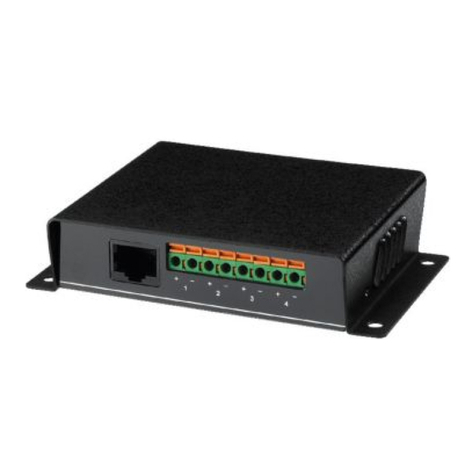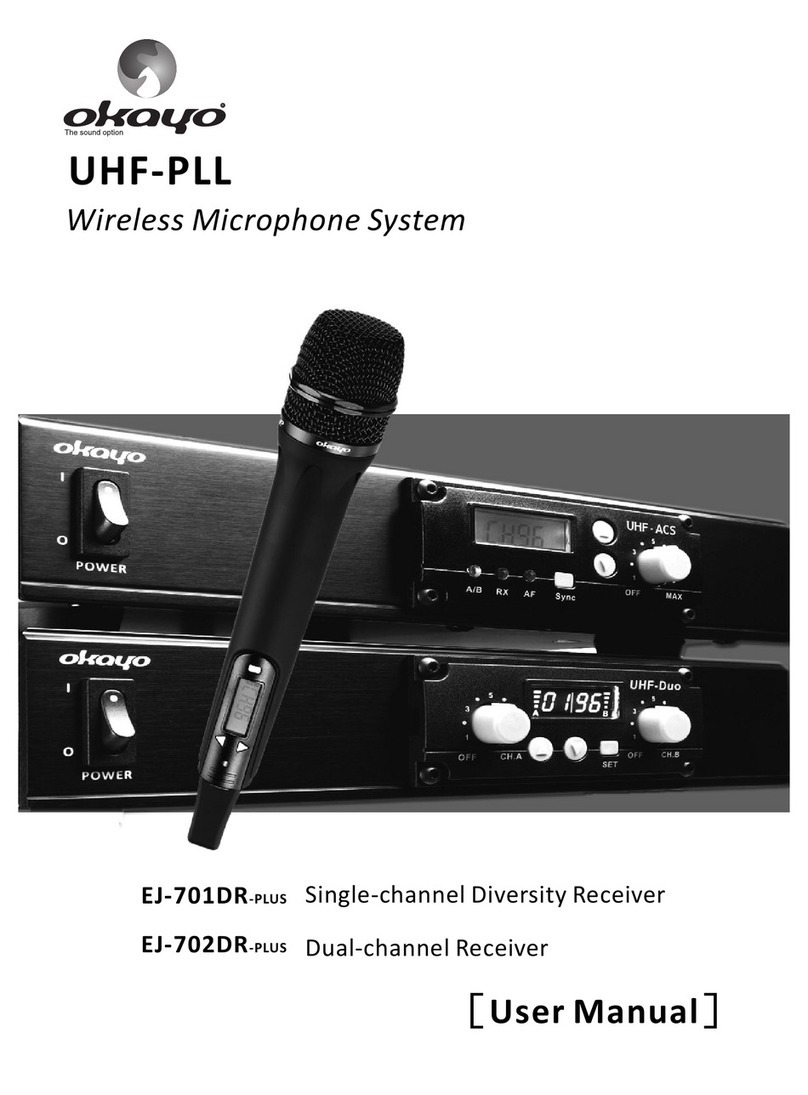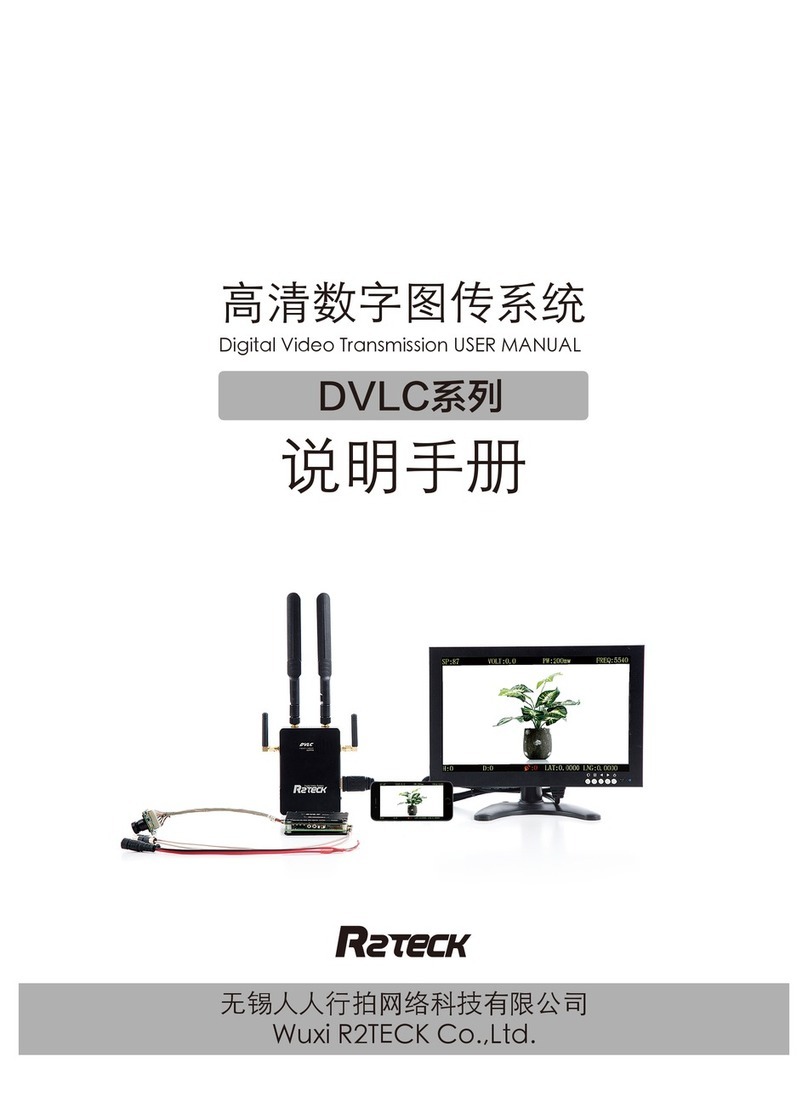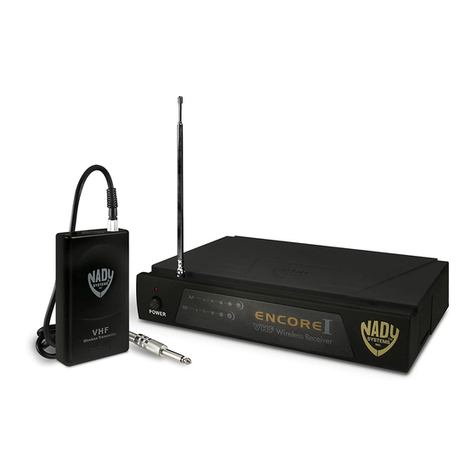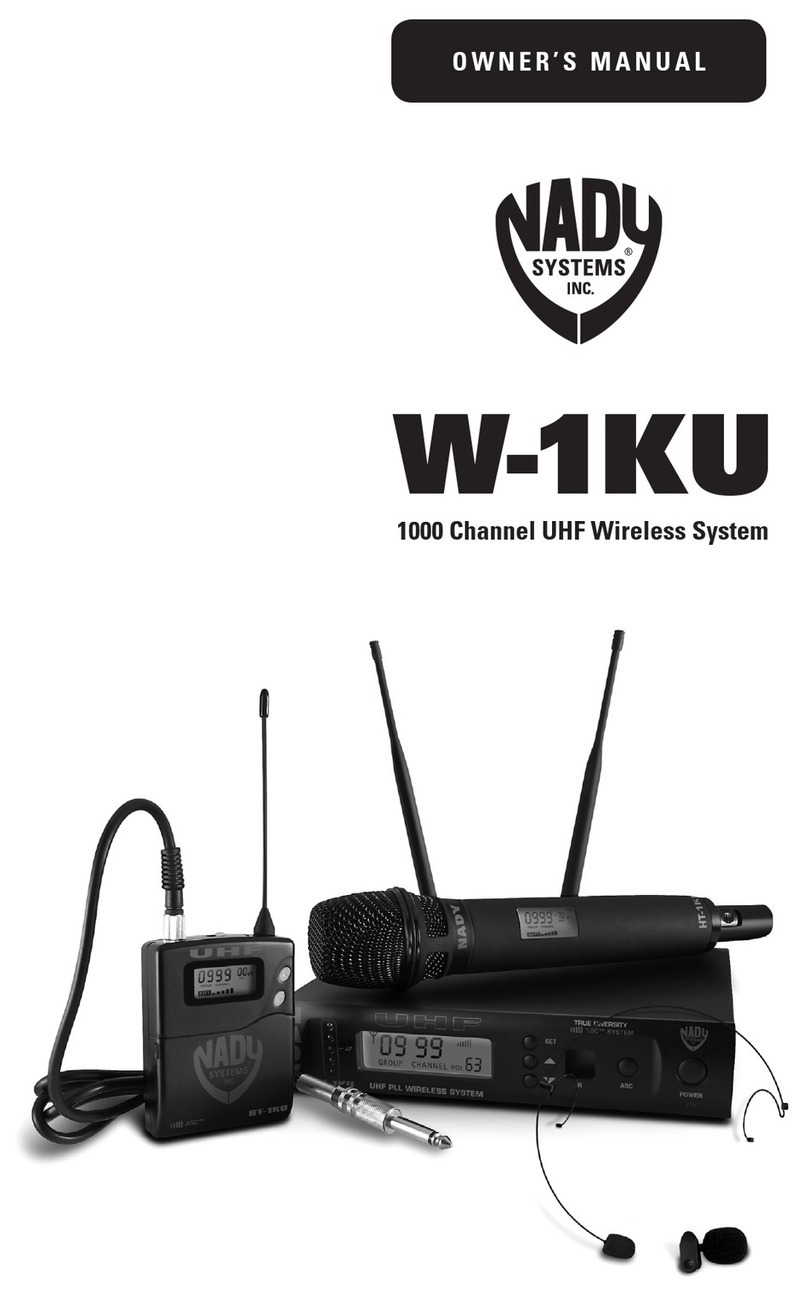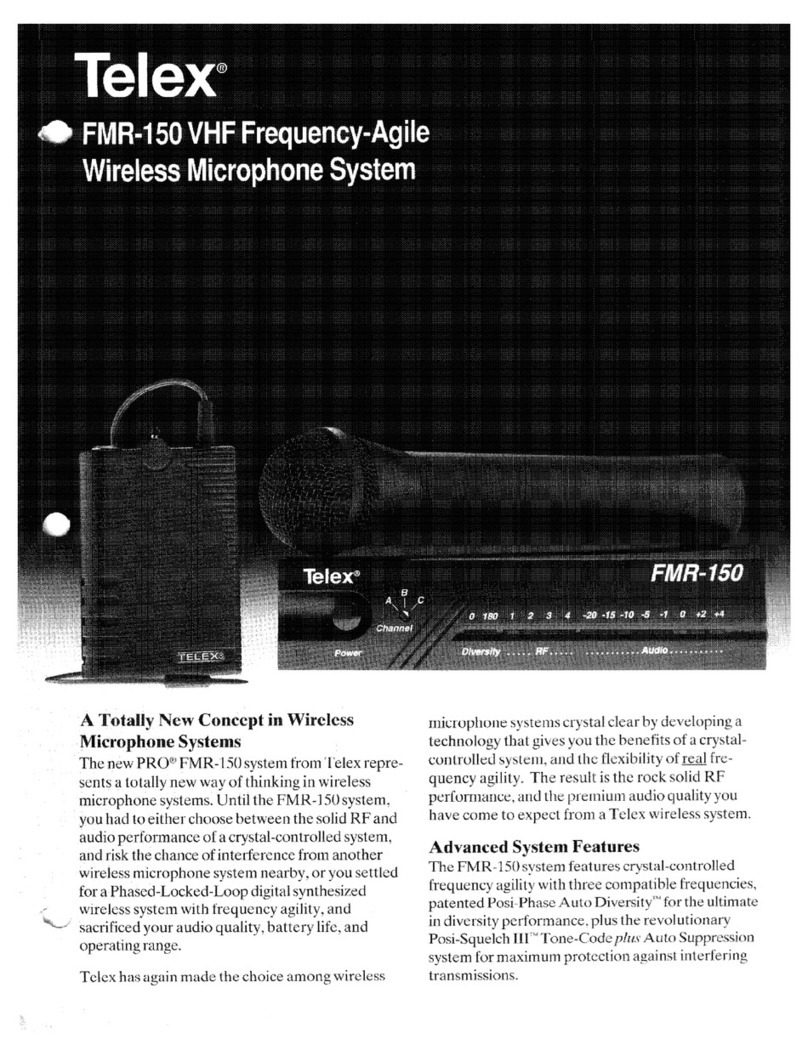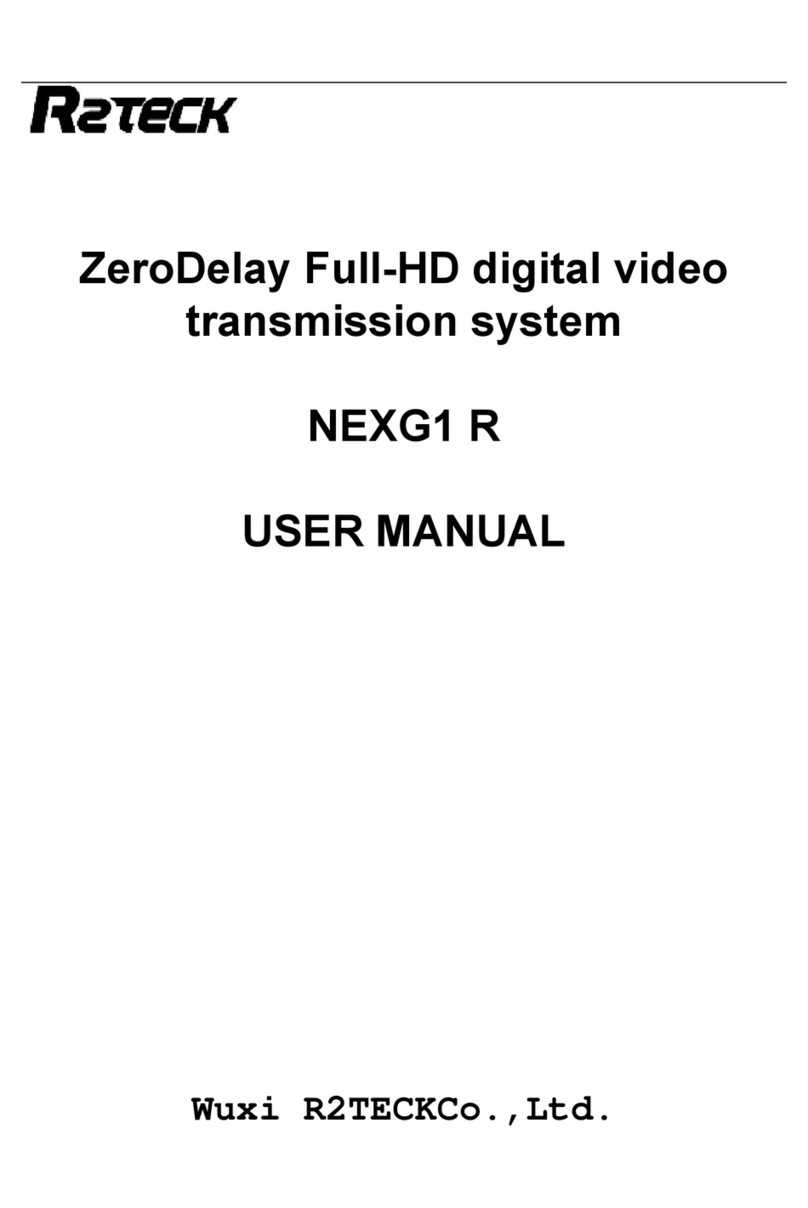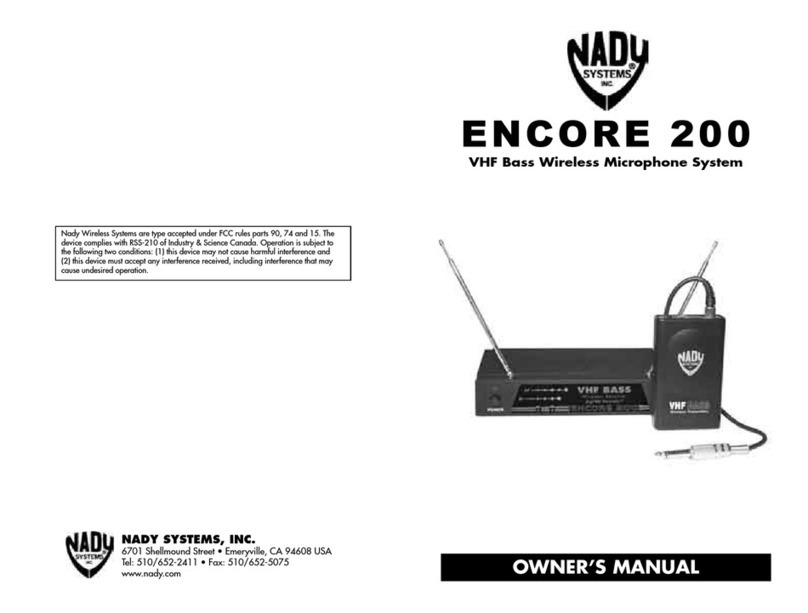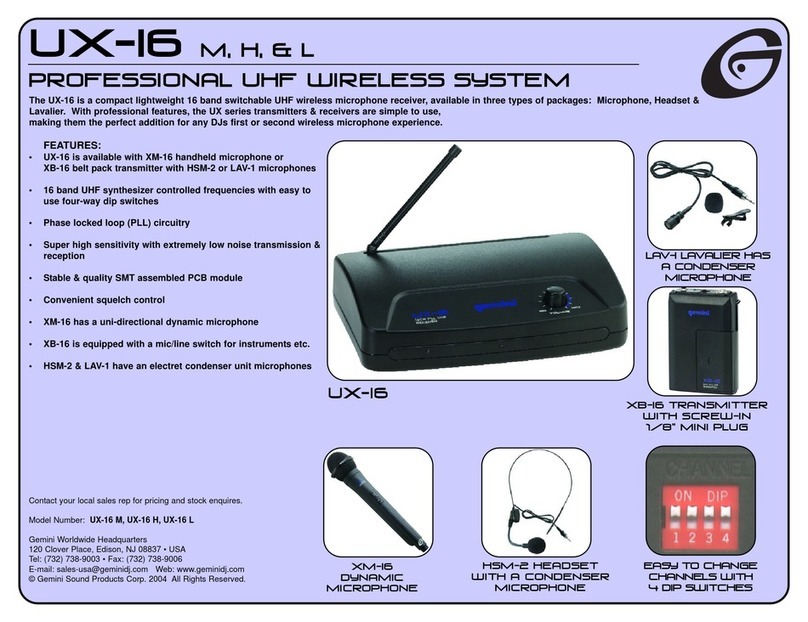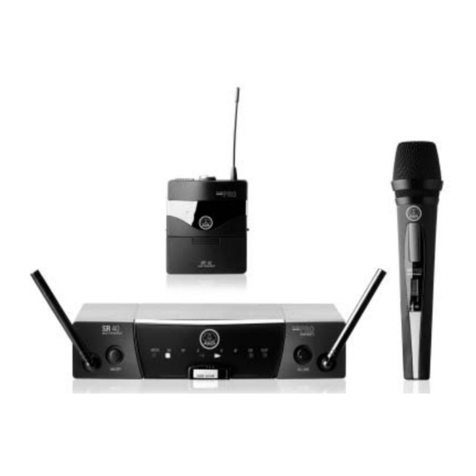Smooth Hound Innovations Ltd. Classic User manual

Inialisaon Error
If the Transmier Connecon LED is on connuously (not blinking) or all
three of the Receiver bars are ashing connuously this indicates an
inialisaon error. Remove baeries from the K1100 and turn othe
K2100. Wait 20 seconds then replace baeries and switch on.
Get Started
1. Insert 2xAAA baeries provided into the K1100 Transmier
2. Plug the Transmier into instrument
3. Press and hold the Transmier buon for 1 second to turn ON or OFF
4. Plug DC adapter into K2100 Receiver
5. Connect Receiver to amp
6. Turn on Receiver
1
2
3
DCONLY
Made inEngland
9V250mA
K2100
wirelessreceiver
I
O
4
5
6
Geng started with the Classic Wireless Guitar System couldn't be simpler.
Plug them in, turn them on and play.
Bind Transmitter To Receiver
A K1100 Transmier and K2100 Receiver must be bound together before
they can connect. The Wireless Guitar System includes devices that are
already bound together. A Transmier can only be bound to one receiver at a
me.
power
ON
CLICK
double
< 5 secs
bind
mode
Bind a Transmier to a Receiver
by turning both othen turn
them on in turn and set to bind
mode with a double click within
5 seconds. Connecon LED
double blinks during bind.
An unlimited number of Transmiers can be bound to a single Receiver but
only one Transmier can connect to a Receiver at a me. The Receiver will
connect to whichever Transmier responds rst so simply power OFF
devices that are not being used.
Change Receiver ID
Each K2100 Receiver is programmed with a unique ID that it uses for binding
to Transmiers. It is possible (but very unlikely) that systems with similar IDs
can connect to devices that they are not bound to. If this happens, the
Receiver's ID can be changed to one of three alternate IDs. If this is done, it
will be necessary to re-bind Transmiers to the Receiver.
power
ON
hold PRO
buon
bind
mode
Change a Receiver ID by
turning it othen holding the
PRO buon while turning it
back on again. The Receiver
will enter bind mode to re-
bind to an Transmier.
ID
change
Microsuction Tape
Here's a piece of 'Microsucon Tape'. It'll hold your K1100 Transmier in
place on your guitar but will come oeasily when you want it to and will
not leave a residue. It uses nano-technology to create thousands of sucon
cups to sck to smooth surfaces.
1
2
2
The tape has a strong acrylic adhesive on one side. Peel the white
backing paper away and use this adhesive to sck the tape to the baery
door of the K1100 Transmier.
The dark side is the microsucon side and has a protecve lm covering
it. Remove this before use. The tape works best when it's clean. If it gets
dirty, you can remove the baery door and wash it and the Microsucon
tape in warm soapy water.
Trouble Shooting
Radio Interference
Protocol-K uses radio waves in the 2.4 GHz band which is shared with
other technologies such as WiFi, Bluetooth (both on computers, tablets
and cell phones) and other proprietary wireless audio systems. Protocol-K
uses an adapve algorithm to select the four cleanest channels for audio
data whilst tesng a further four channels as backup from 79 channels
available. It's a very robust system but in an environment with many other
devices transming, a reliable connecon cannot be guaranteed.
If you experience high levels of interference and unreliable connecon, try
the following:
- Check the baeries in the transmier
- Turn oany unused wireless audio systems (they will be using radio
channels even if not transming an audio signal)
- Turn oor disable unnecessary WiFi or Bluetooth devices
- Increase the distance between compeng systems (a minimum of 3m
separaon is recommended)
- Ensure there are no large metal objects between transmier and receiver
- Move the receiver away from large metal objects
- Reduce the distance between transmier and receiver
No Sound from Amp
- Check that there are fresh baeries in the Transmier and the system is
wired correctly (see GET STARTED)
- Check that Transmier and Receiver are 'Connected' (see STATUS
INDICATORS)
- Contact support@smoothhound-innovaons.com
Transmier and Receiver do not connect
- Check that Transmier and Receiver are 'Bound' (see BIND TRANSMITTER
TO RECEIVER)
- Contact support@smoothhound-innovaons.com
DEFAULT
DEFAULT DEFAULT
Fine Tuning
1
2 3 4
The K2100 Receiver has three adjustable controls: Cable Tone, Latency and
Power Save. The default sengs will be ne for most situaons but if you
want to tweak, this is how to do it.
LONG PRESS
enter control
mode
CLICK
select
control
enter set
mode change
value
conrm &
exit
1. Control Mode The PRO buon enters control mode and changes values.
CLICK
LONG PRESS LONG PRESS
2. Cable Tone
Cables aect guitar
tone subtly by the way
they load the pickups.
The result is a cut in
the highs. The Classic
has no cable so may
sound brighter than
you're used to. If you
want a warmer tone,
increase this control.
3. Latency
The me it takes to
send the sound from
your guitar to your
amp is always very
short (8ms) but can be
made even shorter
(5ms) with this control.
Only recommended for
low interference
environments.
4. Power Save
Turns the Transmier
oautomacally if
instrument is not
played for a period of
me.
Lowest latency
Highest link integrity
Transion mid
Transion high
30Cable
Cable Tone OFF
10Cable
20Cable
Power Save OFF
Power Save 10 min
Power Save 30 min
Power Save 60 min
2. Signal Strength
Bars show the current
received signal
strength.
3. Interference
Bars show the
amount of
interference being
seen by the Receiver.
Interference can come
from WiFi, Bluetooth
& other 2.4 GHz
devices. Protocol-K
moves quickly away
from channels that
have high interference
but if there's nowhere
leto go, you'll see
more red bars and
connecon will
become unstable.
4. Baery Charge
Bars show the
condion of the
Transmier baeries.
A single blinking bar
shows you're almost
out and the
Transmier will shut
down soon.
Status Indicators
1. Connecon Status
Transmi�er bu�on LED
Connected - Slow blink
Searching - Fast blink
Binding* - Double blink
Receiver white LED
Connected - On
Searching - Fast blink
Binding* - Double blink
* See 'Bind Transmier to Receiver'
1
1
2 3 4
The K1100 Transmier and K2100 Receiver show the state of their wireless
connecon, signal strength/quality and Transmier baery charge.
Approx. Time Le
15 hours
12 hours
8 hours
2 hours
Excellent
Good
Weak
Poor
Poor signal strength
will lead to break-up of
the guitar signal. Move
closer to the receiver.
Wireless Guitar System
User's Manual
Certifications
Information To The User
This wireless system operates in the globally available ISM band 2400 MHz to
2483.5 MHz. The operaon does not require a user license.
Meets requirements of the following standards: EN 300 328 EN 301 489
Parts 1 and 9 EN60065. Meets essenal requirements of the following
European Direcves: R&TTE Direcve 99/5/EC, WEEE Direcve 2002/96/EC,
as amended by 2008/34/EC RoHS Direcve 2002/95/EC, as amended by
2008/35/EC. Note: Please follow your regional recycling scheme for baeries
and electronic waste.
The CE Declaraon of Conformity can be obtained from:
www.smoothhound-innovaons.com/europe/compliance
This equipment had been tested and found to comply with the limits of EN
300 328. These limits are designed to provide reasonable protecon against
harmful interference in a residenal installaon. This equipment generates
uses and can radiate radio frequency energy and, if not installed and used in
accordance with the instrucons, may cause harmful interference to radio
communicaons. However, there is no guarantee that interference will not
occur in a parcular installaon. If this equipment does cause harmful
interference to radio or television recepon, which can be determined by
turning the equipment oand on, the user is encouraged to try to correct
the interference by one or more of thefollowing measures:
• Reorient or relocate the receiving antenna.
• Increase the separaon between the equipment and the receiver.
• Connect the equipment to an outlet on a circuit dierent from that to
which the receiver is connected.
• Consult the dealer or an experienced radio/TV technician for help.
SmoothHound
Smooth Hound Innovaons Ltd.
Cambridge
United Kingdom
Email: info@smoothhound-innovaons.com
www.smoothhound-innovaons.com © 2015 Smooth Hound Innovaons Ltd.
Classic
